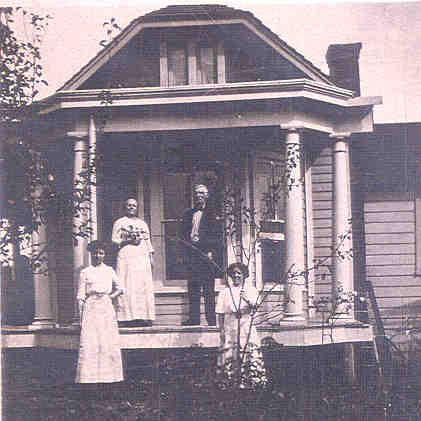Silver Spring: Then & Again
By Jerry A. McCoy
Silver Spring Voice
February 2005
In August 2004 Then & Again featured Marguerite F. Thomson's memories of a 1952 incident that occurred at the Sligo Creek Cabin (also known as the Blair Cabin) that stood on Wayne Avenue near the old Montgomery Blair High School.
This month I am pleased to present a remembrance written by Mary Margaret Dickson, a charter member of the Silver Spring Historical Society who passed away on December 4, 2004 at the age of 85. Mrs. Dickson was born in Silver Spring and graduated from Montgomery Blair High School in 1937. A lifelong resident of Silver Spring, she appeared in the 2002 documentary Silver Spring: Story of an American Suburb.
The Silver Spring Historical Society gratefully appreciates the permission granted by Daniel M. Dickson to share his mother's important early memories of Silver Spring.
Early Silver Spring as I Remember
by Mary Margaret (Perry) Dickson
June 1999
Starting at the DC line. - I remember back in the 20s when they held jousting events in a field on the northwest corner of what is now Georgia Ave. & Eastern Ave. At the time, Eastern Ave. was the driveway to the Lee estate. Georgia Ave. was known as the 7th Street Pike. Going north on Georgia Ave., a private estate belonging to Jesup Blair was located on the east side. It later became Jesup Blair Park.
In later years, the Silver Spring Fire Department held carnivals on the west side of Georgia Ave. We would walk up to the carnival grounds in the evening and cross Georgia Ave. at the ground level railroad crossing. I remember being afraid we wouldn't make it before a train would come. The Dying & Cleaning Institute opened in about 1930 and was located just before the railroad crossing on the east side of Georgia Ave.
The Silver Spring Bank was located on a hill at the corner of Georgia Ave. & Sligo Ave. At the time, Sligo Ave. was called Blue Stone Road. The bank located at Georgia Ave. and Bonifant Street (Nation's bank) opened around 1925 and closed about 1997/98.
On the eastern side of Georgia Ave. were private homes. The railroad station on the west side was also the home of the stationmaster and his family. On the east side of Georgia Ave. (present location of the Silver Spring Volunteer Fire Department) was the Armory and fire department. Two engines were kept in the front of the building and the Armory was located in the back. Mrs. Woodson ran a garage next to the fire department for many years. My grandmother was visiting the railroad stationmaster's wife when he received the message by telegraph that the Woodson's son had been killed in WWI. My grandmother went with the stationmaster to notify Mrs. Woodson of her son's death.
The Armory was used on Sundays for church services when the visiting minister came to town. It was also used as a local playhouse. People from the neighborhood were the actors. My mother would blacken her face and sing songs. I remember one of the songs she sang was "Plant a Watermelon Vine on My Grave so the Juice Can Seep Through".
In the early 1930s, Blair Lee donated a building lot located between Silver Spring Ave. and Sligo Ave. to the newly formed Ascension Church (Episcopal).
I started elementary school in 1925 and attended the 1st, 2nd & part of the 3rd grade at the Takoma/Silver Spring High School on Philadelphia Avenue and Chicago Avenue. At the time, the 4th through 8th grades attended school in two of the new stores on Georgia Avenue between Thayer Ave. and Silver Spring Ave. When East Silver Spring Elementary School (E.S.S.) was completed around 1927, our classes marched over to our new building. My dad was in charge of putting up the playground equipment for the new school. He was also in charge of keeping the dodge balls blown up. I would often bring balls home at the end of the day for him to repair.
Our 1st grade teacher was Mrs. Davis, 2nd grade and 3rd grade (joint) was Miss Wooton, 4th grade was Miss Warfield, 5th Miss Dungan, 6th Mrs. McDonald and 7th was Miss Monrad (the principal) in the morning and Mrs. Vivian in the afternoon. I graduated in June of 1932 from E.S.S. I attended E.S.S through 7th grade and returned to Takoma/Silver Spring High School for the 8th and 9th grades.
I entered Montgomery Blair High School at the corner of Wayne Ave. and Dale Dr. in September of 1934. It was just a 3-story building when I attended. The gym, assembly hall, and school cafeteria were all located on the 3rd floor of what was later know as "C" building. Total enrollment was about 300 students. Our 1937 graduation class (first class to attend all three years at Blair) consisted of just over 100 students.
I later attended Southern College in Petersburg, VA from 1938-39 and The Washington School for Secretaries in 1940. I worked for the 4th District of the Civil Services Commission in Washington, DC and transferred to the Civil Service Information Office when the 4th District moved to NC in 1942.
Dudley's Drug store was on Georgia Ave. between Silver Spring Ave. and Sligo Ave. They later moved to the corner of Thayer Ave. and Georgia Ave. At the corner of Sligo Ave. and Georgia Ave. was Gifford & Perry's Lumber Co. (later moved to Colesville Rd. and 2nd Ave.).
One of the stores on Georgia Ave. at Sligo Avenue was a bakery run by my Aunt Margaret Faulconer's mother Mrs. Rykard. Aunt Margaret married my mother's youngest brother Lauman T. Faulconer. Aunt Laura Faulconer (married Uncle Ned Faulconer) worked for Mrs. Rykard at the bakery. Later Mrs. Rykard opened a family restaurant on the east side of Georgia Ave. between Bonifant St. and Wayne Ave. (Wayne used to be called Montgomery Ave.). Mrs. Rykard lived in a house on the west side of Georgia Ave. at Plyers Mill Rd. She later opened an inn in her home before she bought a hotel on the Patuxent River and opened the 7 Gables Hotel.
My grandmother and grandfather Faulconer bought 2 acres in the 700 block of Thayer Ave. Their sons John (740/742) and Edward (732/734) bought ½ acre each from their father and grandmother's sister and brother-in-law Bettie and Jim Magee also bought a ½ acre (728/730). My grandmother left my mother the remaining ½ acre (736/738). My brother and I were born in my grandparent's home at 736 Thayer Ave. At the time, the house had no electricity and no running water. Water was pumped from a well and piped to the kitchen sink. My dad had electricity and a bathroom installed between 1924 and 1926.
We lived in a small 4-room house my dad and grandfather built on the corner of Grove St. and Thayer Ave. (800 block) facing Thayer Ave. Later my dad sold the land and house to Mr. Herbert Cissel. He had the house moved to face Grove St. and built two houses that faced Thayer Ave. and another house next to our old house on Grove St. at the corner of Grove and Thayer.
We moved to 736 Thayer Ave. to live with my grandmother after my grandfather died in 1925. Before we moved in with my grandmother, my dad purchased a lot on the corner of Grove St. and Cedar Lane (now Bonifant St.). My grandmother died in August of 1926. My dad started building our house on Bonifant St. (800, later 820) in 1929. It was a Sears Roebuck ready cut house. Each piece of lumber was marked and it went together like a big jig saw puzzle.
Then came the depression. Our house payments were $63 a month. To help make ends meet, my mother took in 4 roomers/borders at $10 each month from the new Dying & Cleaning School on Georgia Ave. My dad, William E. Perry, was an attorney reviewer for the Veterans Administration in Washington, DC. During the depression everyone took a cut in their take home pay. He took a second job at night in my Uncle John's Silver Spring Bowling Alley (Wayne Ave. just of Georgia Ave.).
Uncle John Faulconer and his son-in-law Frank Proctor built a number of houses in Woodside Park and the Silver Spring area. He and his wife Edna lived at the corner of Highland Dr. and Woodland Dr. When my brother and I would walk up to see our cousin Dick Faulconer, we would walk the streetcar line that was a single track up Georgia Ave. from the DC line to Forest Glen. Since there was only one track, there was a bypass in front of the Woodside School where the car would pull in and wait for the returning car to come from Forest Glen.
Crosby Rd. was just a driveway for the Castle House (9207 Crosby Rd.). Woodshed Parkway was just a field in those days. The wooded area was cleared of underbrush so the Noyes family and their friends could go horseback riding. Noyes Dr. and Highland Dr. were the entrance to Woodside Park with a stone arch located at each entrance.
Uncle John built the first apartment house in Silver Spring. It was a 3-story building located on the east side of Georgia Ave. between Wayne Ave. and Ellsworth Dr. I remember well my brother and I walking up those stairs each day to deliver the Daily News newspaper.
Uncle John also built the first movie house in Silver Spring. It was called the Seco Theater (later know as Roth's Theater) at the intersection of Georgia Ave. and Thayer Ave. Mr. and Mrs. Fred Lutes had a store connected to the theater called the "Little Sweet Shop". On the other side was a lady's dress shop run by Mrs. Helen Brennon.
East on Houston St. was a hospital for WWI Army Veterans who needed hospital care. It later became a hotel and then Bullis School in about 1935 or 1936.
A small post office was located in one of the stores on Georgia Ave. between Silver Spring Ave. and Sligo Ave. Later it moved behind the 5 & 10 store at the corner of Thayer Ave. and Georgia Ave. while the post office on the west side of Georgia between Bonifant St. and Wayne Ave. was being built. My friend Lucile Hendricks Rieve was the first "Miss Silver Spring" at its opening in 1936. It moved again a few years ago to its current location on 2nd Ave. The Silver Spring Post Office recently celebrated its 100 anniversary.
Back in the late 20s we would go to Georgia Ave. in the evening on weekends and roller skate on the sidewalks while our parents would sit in their cars and talk to their friends. In those days everyone knew everybody. It was a friendly town back then.
Oral histories are invaluable documents in that they preserve historical information found nowhere else. If you grew up in Silver Spring and have memories of the downtown area, no matter how new they might be, please consider preserving them for future generations and email them to the Silver Spring Historical Society at sshistory (at) yahoo.com or mail to SSHS, PO Box 1160, Silver Spring, MD 20910-1160. Our web site is www.sshistory.org.
Historians will thank you as this one does now, "Thank you Mrs. Dickson!"



